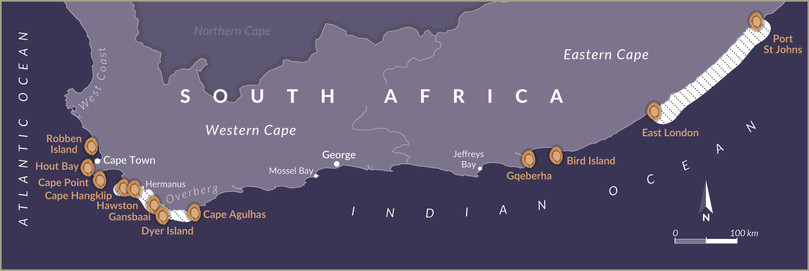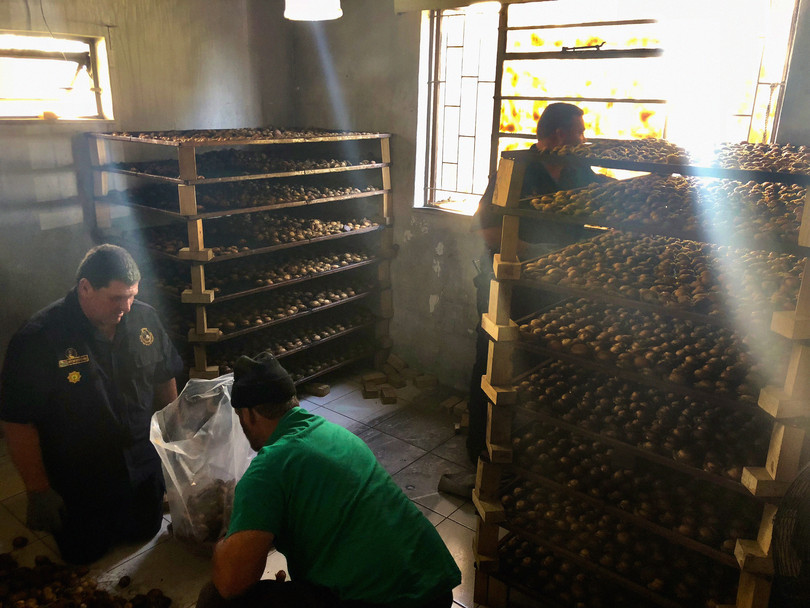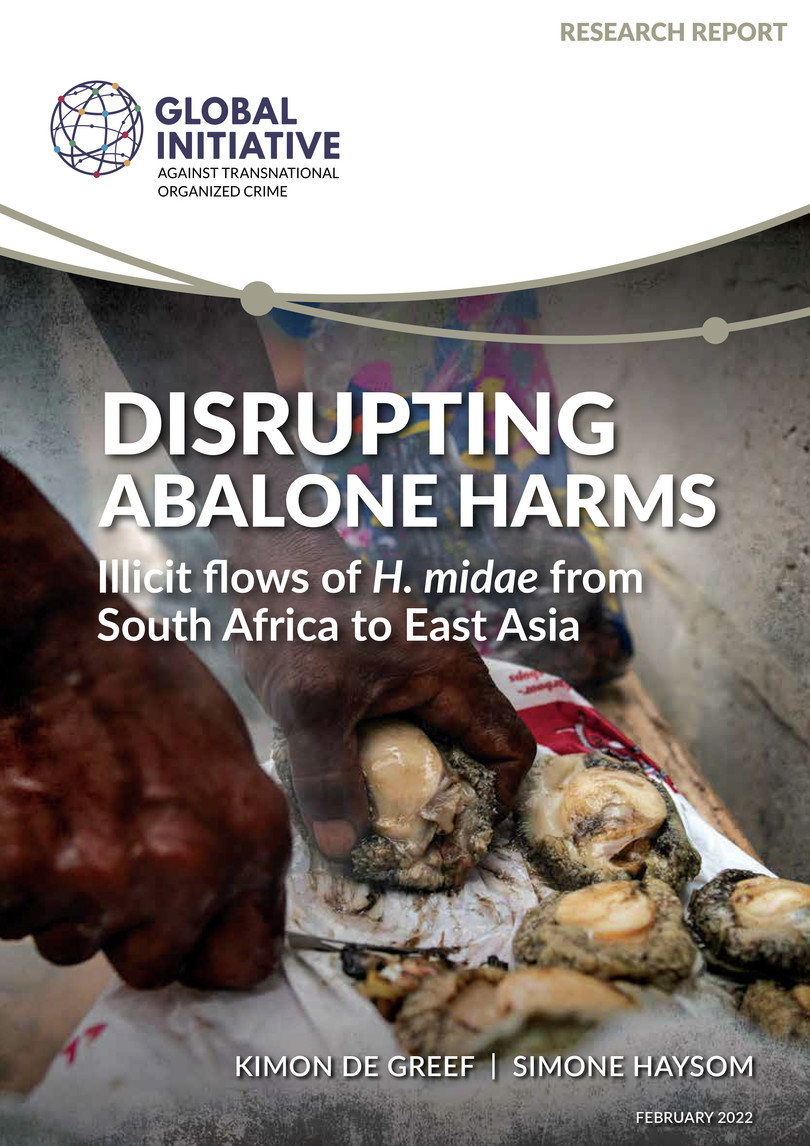A violent environmental market: the heavy cost of South Africa’s abalone trade.
The illicit abalone economy has been flourishing in South Africa for more than 25 years. Demand for the sea-floor-growing molluscs (considered a high-status delicacy in East Asia, primarily in China) has driven a black market, which, in South Africa, is closely bound up with organized crime. The industry today is rife with violence and corruption, enmeshed in the drug trade and controlled by local gangs. Consequently, the already harsh environmental and social impacts of the abalone trade continue to worsen.
Abalone poaching occurs along most of South Africa’s coastline, with hotspots in the Cape peninsula and Overberg regions of the Western Cape, the portion of the Eastern Cape coast up to Gqeberha, and further north up to the Wild Coast.1 Once caught, the product is shucked and dried at some of the many processing facilities throughout the country.2
Dried abalone is then smuggled to Hong Kong, an abalone trade hub that imports thousands of tonnes of the mollusc each year. The product reaches Hong Kong either directly from South Africa or, increasingly, by being smuggled overland to neighbouring southern African countries, where it can easily be laundered into the large and legitimate global market for abalone.

Figure 2 Global routes of illicit abalone trade and abalone poaching territory in the Western and Eastern Cape provinces, South Africa.
The changing political economy of South Africa’s abalone industry
South Africa’s illegal abalone market began thriving in the early 1990s, spurred by demand from China’s newly opened economy and fast-growing middle class. This provided a lucrative opportunity for black and Coloured fishers who had been excluded from South Africa’s commercial fishing industry – first, during the apartheid era, and then in its immediate aftermath, as a result of the slow progress of regulatory reforms. Throughout the 1990s, organized-criminal gangs based in Cape Town – already involved in retail drug markets – were drawn into the abalone trade as extortionists (demanding protection fees from divers), middlemen and as the owners of poaching vessels. While the gangsters brought violence and drugs to South Africa’s fishing communities, the poaching economy provided a revenue stream for gangs to buy weapons and drugs, thereby handing gangs greater power and having a transformative effect on the gangs themselves.
Today, the abalone market is a complex ecosystem. As of 2020, five distinct groups of actors could be identified working in the illegal trade: poaching syndicates (known as ‘divers’) that developed out of Coloured fishing communities in the Western Cape; black poaching syndicates and divers from the Eastern Cape, working in the Overberg and Cape Town area, who are increasingly affiliated with gangs; Cape criminal gangs, in particular those associated with the notorious 28s prison gang; Somali (and sometimes Congolese) South Africa-based middlemen buying from black divers, and arranging transport and laundering for Chinese buyers; and Chinese networks encompassing buyers, driers and exporters.3 These elements of the supply chain suggest a striking division between local actors, operating primarily in the bottom half of the value chain, and foreign nationals operating mainly at the top.
In addition to the criminal networks directly involved in the abalone trade, there are a range of people who can be considered as ‘enablers’ of the illicit market. These provide crucial professional services, such as facilitating financial transactions or providing legal or logistical services, and in many ways make the criminal trade possible.
Figure 3 Organizational structure of the illicit abalone global supply chain and estimated number of participants.
SOURCE: Kimon de Greef and Simone Haysom, Disrupting abalone harms: Illicit flows of H. midae from South Africa to East Asia, GI-TOC, February 2022
Rigid control at the higher levels of the trade chain
Networks of Chinese high-level traffickers operate in Cape Town and Johannesburg, South Africa’s biggest logistics hub. According to interviews with law-enforcement officers,4 and people close to operators in the abalone industry, there are very few of these traffickers who control illegal abalone exports to Hong Kong at a high level.
These Hong Kong bosses reportedly dictate where top-level buyers – those who buy abalone, dry the product and arrange for its export – are allowed to work, which local middlemen they are allowed to deal with, and what quantities of abalone they are expected to supply.5
So-called operational managers in South Africa monitor the buyers and help coordinate exports. The level of oversight is such that investigators struggle to execute reverse entrapments, as the arrival of any abalone on the market that hasn’t been accounted for by a buyer in the network raises suspicions, no matter how small: ‘If as little as 300 kilograms of abalone enters the market, the Chinese immediately know who took it in and who they bought it from,’ one senior investigative official said.6
Officials describe a system where prospective buyers must first be approved and then play by the rules to do business. Occasionally, buyers take in abalone intended for rivals, but only in small quantities, so they aren’t detected. Officials estimate that fewer than 40 buyers work at this level, most of them Chinese. They have been joined, in the past few years, by a small number of Somali traffickers who have entered the trade.7
Violent competition closer to source
Beneath the tightly controlled upper levels of the trade are ‘frontline buyers’, who deal directly with poaching syndicates and gangs. This level of the market is characterized by greater amounts of disorder and competition.8 There is continual low-grade war between frontline buyers over attracting divers’ catches.
At the level of poaching syndicates, there is much fluidity: gang extortion, high levels of competition and, at times, extreme violence means that there is significant turnover of people involved in the market.9 Poachers refer to the chain of transactions between the harvesting of the abalone and its delivery to a frontline buyer as a ‘line’ (or lyn, in Afrikaans).10 A ‘line’ implies integration and organization of the chain, which includes securing protection from corrupt officials.
However, the chain of transactions that connect poachers and buyers is in fact unstable: an ambitious boat driver with the capital to buy his own equipment, establish a connection to a corrupt official, and communication links with a frontline buyer, can break away and form his own operation. Divers with their own scuba-diving equipment can work independently from poaching syndicates and simply sell their products directly to frontline buyers. Although significant capital is required, resourceful divers can acquire the necessary equipment and essentially leapfrog the system and become criminal entrepreneurs.
The presence of individual actors contributes to the fragmentation of the market and broadens the scope for violence. These entrepreneurs vie for a stake in the market while more established players try to prevent them from muscling in on it. Increased competition at this level has resulted in a high rate of violent incidents (five senior police informants were reportedly killed in 2021 alone), and a greater number of episodes of poaching groups robbing one another have been observed.11 These trends have had a destabilizing effect on the market.

Police raid an abalone-drying facility in Soshanguve, north of Pretoria, on 20 January 2018.
Photo: Julian Rademeyer
The role of foreign nationals
Somali and Congolese groups are identified as being involved mainly in the transport phase, with the latter acting as logistics partners and the former also involved as middlemen buying from poachers and arranging transport and laundering services for Chinese networks.12
When drying facilities are raided by law enforcement, those arrested are often reported as undocumented foreign migrants from southern African countries (e.g. Malawi and Zimbabwe) or Pakistan. It is thought that buyers may invest heavily in training migrants to be highly skilled driers, as the quality of this process has consequences for the final price that can be charged for the goods.
Overall, the number of smaller poaching and drying businesses has grown – especially those businesses involved in buying from local middlemen to sell to exporters. Many small shopping malls (known as ‘China malls’), where goods are sold wholesale, are believed to double as hubs for the illicit abalone trade.13
Limiting the social harms of the illegal abalone trade
As with other forms of illegal wildlife trade, the abalone market has been criminalized because of its environmental harms: the degradation of a species endemic to South Africa (H. midae), and the knock-on effect on the integrity of kelp-forest ecosystems.
Yet there are also acute social repercussions linked to the illicit abalone trade, including increased violence and corruption, and burgeoning arms and drugs markets spurred by financial flows to criminal gangs. These harms have also become more acute over time, as a greater range of criminal actors have become involved in the trade, with highly detrimental consequences for certain Cape communities.
Globally, drug policy reforms have successfully shifted towards approaches that aim to limit the harmful social effects of these illegal markets. It may be time for the illegal abalone trade to also adopt a similar harm-reduction approach.

This article draws on research from ‘Disrupting abalone harms: Illicit flows of H. midae from South Africa to East Asia’, a new GI-TOC study by Simone Haysom and Kimon de Greef published in February 2022. Available at: https://globalinitiative.net/analysis/abalone-south-africa-east-asia/.
Notes
-
S Raemaekers et al., Review of the causes of the rise of the illegal South African abalone fishery and consequent closure of the rights-based fishery, Ocean & Coastal Management, 54, 2011, 433–445. ↩
-
N Okes et al., Empty shells: An assessment of abalone poaching and trade from southern Africa, TRAFFIC, 2018, https://www.traffic.org/publications/reports/empty-shells. ↩
-
Elizabeth Marx, dubbed the Poaching Queen by the press, ran a massive poaching operation in Gansbaai during the first decade of the 2000s. Upon her arrest, a court order authorized the state to seize assets worth R16 million from the syndicate, including two houses, a farm, 15 vehicles and two boats; see John Yeld, Court orders poaching suspects’ assets seized, IOL, 19 February 2003, https://www.iol.co.za/news/south-africa/court-orders-poaching-suspectsassets-seized-101615. Marx was later convicted and jailed. ↩
-
Interviews with Marcel Kroese, former head of enforcement at the national fisheries department, Cape Town, February 2021, by phone; interview with senior Hawks official, Cape Town, November 2020, by phone; interview with senior provincial detective, Cape Town, November 2020, by phone; interview with former associate of several abalone syndicates, December 2020. ↩
-
Jonny Steinberg, The illicit abalone trade in South Africa, ISS Paper 105, Institute for Security Studies, 5 April 2005, https://issafrica.org/research/papers/the-illicit-abalone-trade-in-south-africa; interview with senior Hawks official, Cape Town, May 2021. ↩
-
Interview with senior Hawks official, Cape Town, November 2020, by phone. ↩
-
Interview with senior Hawks official, Cape Town, November 2020, by phone; interview with senior provincial detective, Cape Town, November 2020. ↩
-
Interview with Angelo Joseph, community organizer in Hout Bay, Cape Town, December 2020, by phone. ↩
-
Interview with senior Hawks official; see also Kimon de Greef and Shuhood Abader, Poacher: Confessions from the Abalone Underworld, Kwela, 2018. ↩
-
Interview with Angelo Joseph, community organizer in Hout Bay, Cape Town, December 2020, by phone. ↩
-
Ibid. ↩
-
Interview with senior Hawks official, May 2021. ↩
-
Interview with senior Hawks official; interview with abalone poacher who has sold directly to buyers at China malls, November 2020; see also Kimon de Greef and Shuhood Abader, Poacher: Confessions from the Abalone Underworld, Kwela, 2018. ↩
